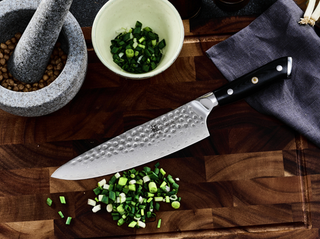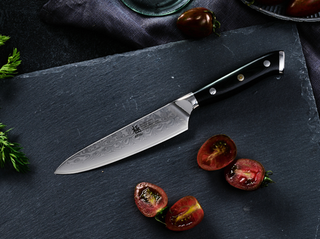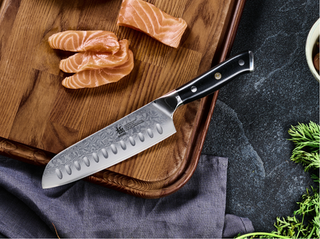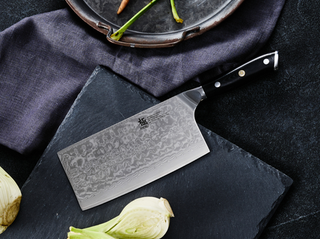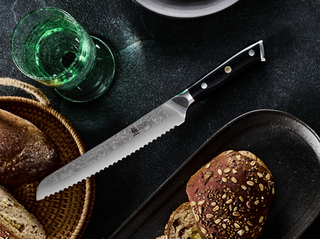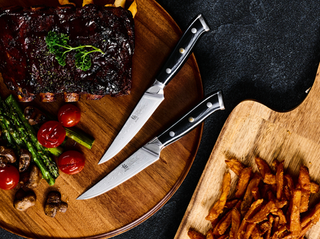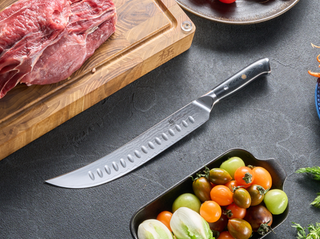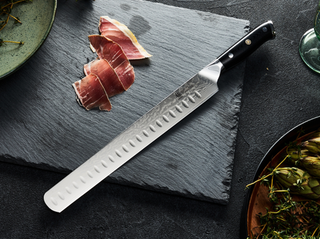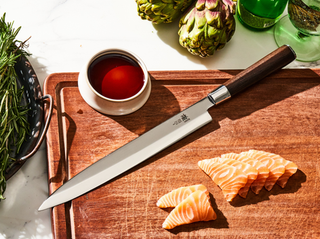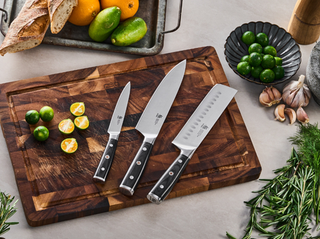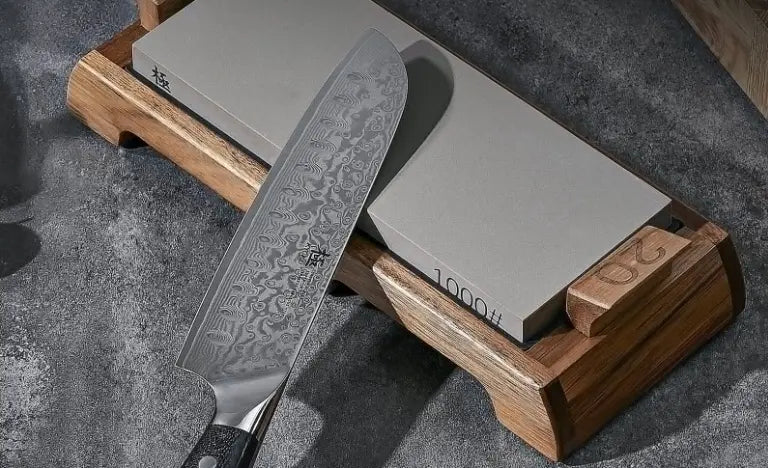Using a knife to slice, swivel, and splitter demonstrates your chef's potential, even if you're not one. This happens due to a fragmented edge that has endured so much to prep primed and seasoned food for you. It's really heart-wrenching to see your favorite blade lose its exquisite sharpened rim. It forewarns about an impending kitchen disaster. So why not use a whetstone knife sharpener to rescue your cooking mission? – It’s a thick rectangular brick made from natural stones, durable synthetic stones, combination stones, or diamond stones.
Remember, delicious dishes don't revolve around exotic ingredients, secret recipes, and first-rate cooking ranges; it's the cutlery set instead. Inspiration begins at home—with a sheer blade, handheld. Its razor-sharp ridge is swift to inspire and cut through produce and raw meat—like butter. Therefore, having trimmed and pointed knives is crucial to keeping things going smoothly—with the flow.
5 Signs You Need a Whetstone Knife Sharpener
Who knew kitchen cleavers and choppers (knives) would work well with traditional sharpening tools? Seeing those cutting-edge tools and equipment catching dust is surprising—when they’re built to eliminate rush. Skim through the standpoints below before you ask how to sharpen a knife with a whetstone:
1. Difficulty Slicing through Food
One of the most obvious signs the blade requires reckoning is its powerlessness to cut through the most delicate food items. Please do not deliberately force your knife like a saw or axe; you can hurt yourself. Use a Whetstone knife sharpener instead. It not only sharpens the blade but also brings back its pristine condition. Plus, it will help mitigate prolonged prepping times and lessen the wedge-up time. A few more heads-up include:
- You’re putting in extra effort for prep work that once took a single gesture to cut through rigid raw ingredients.
- Soft and delicate food items like tomatoes, cheese, and cake are seemingly squished and torn apart often.
- You’re exhausted and feel uneasiness in your hands after finishing the knife work.
2. Uneven Cutting, Dicing, and Shredding
The other apparent reason you’ll find the cutlery set at fault is their waning razor-sharp edges. You may be able to cut through different pantry items successfully—but not efficiently. This calls for action! This calls for the Whetstone knife sharpener—the perfect tool to repair the blade—and heal those irregularly toothed edges.
- You cannot cut food items neatly without producing a disarray of edible items varying in shapes and sizes—thickness and slices.
- Ingredients and other components are prone to lop-sided cuts and lop-sided choppy texture due to the rickety blades.
- The knife bobs from your hand and bends off course while cutting, indicative of the scanty sharpness.

3. Dull Blade Aesthetics
It isn't always about the blade's sharpness; appeals matter too. So, if you see your kitchen knives with faded shine, it's time to use the reliable Whetstone tool for added effect—to bring the lustrous elegance back.
Below are more visible signs that demand for a revival:
- The blade has seemingly lost its gleaming shine and is covered with dull spots.
- Your knives no longer reflect the light on the walls and faces. Thus, it requires your attention as soon as possible.
- Miniscule dents and nicks are visible on the blades’ edges.
- Low-level performance during the food’s preliminary prepping phase.
4. Frequent Skin Slash Mishaps
Your cutlery set becomes an accidental piece of art instead of its intended purpose—to cut and slice in ship-shape condition. Remember, a dull kitchen knife is a deadly tool in the works; it shears and tears through the skin underhandedly. The results are deep finger cuts, piercing slashes, and whatnot. One thing's for certain: you need to get those knives perked up using a reliable sharpening tool—like the Whetstone.
- You receive swift, off-the-cuff, and unintended cuts and tears on your hands (fingers, palm).
- Your knife becomes unsteady, offering you less control over the unrehearsed dicey friction.
- You are required to put in extra effort without positive results.
5. Conked-out Twisted Shape
Sometimes knives totter and quiver in your hands for no reason. But surely there are underlying factors to deduce. Most often, people read between the lines—assuming the entire piece is beyond repair due to its outward appearance. But that's not the case. Rather, it's the lop-sided blade that needs your attention.
- The knife gets out of shape—it's bent and twisted. Thus affecting its cutting precision and the flat edge flank.
- The misalignment of the knife from the kilt also requires prompt action.
- The blade’s performance is affected by functional issues like uneven cutting and squishing rather than slicing.

What Sets Apart a Whetstone Knife Sharpener
Blade Precision and Control
The brick-shaped design of this sharpening tool has all the answers—and angles to get you through. Yes, you read that right! We wish to handle and maneuver the broken-down blade ourselves. Thus, we get the Whetstone knife sharpener. The tactile form factor with those dimensions gives you the freedom to move, sharpen, and polish the blade you will. On top of that, you can also allow movements with precise adjustments based on the blade's particular geometry. Isn't it great? Sure, it is! The result is a fine-cutting knife—sharpened and slashed—with all its finesse. To pay the honors, there's nothing better than a top-grade whetstone kit with a wooden base.
Multipurpose
The biggest surprise is that you can use the sturdy squared-up sharpener for various purposes. But our primary use case is, of course, in the kitchen—and chef's station. No wonder why the Whetstone knife sharpener outsells those sundry sharpeners available. It can sharpen a wide range of knives, including gyuto (chef's knife), paring knives, cleavers, serrated blades, butchers' knives, etc. The emphasized blade sculptor here is definitely an invaluable addition to the kitchen.
Longer Blade Lifespan
Want to give cats nine lives to your chef's knife set? Say yes, because the whetstone knife sharpener leads the way—from the base to the lip—sheared and pinpointed. This oblong brick may seem rigid, but it's the friendliest sidekick to get for the knives. This traditional sharpening piece of concrete helps diminish rust and clip uneven edges, unlike electric sharpeners that consume metal over time. Thus, you can maintain your razor-shaped knife's original shape and integrity with lustrous sheen and longevity.
One-time Investment
You save your money in the long run. Thus, you must take measures to maintain it just like how you preserve and prep the knives. In contrast, those electric sharpening tools require regular maintenance and demand repair and component replacement. Moral: Traditional handheld means to sharpen knives cut through rust, dirt, and metal bits—not hard-earned cash.
Conclusion
Hence, in a nutshell, investing money in the Whetstone knife sharpener is more than just perfecting the blade. The traditional whetting brick does more than just maintain treasured cutlery set—it sets the standard. You feel more in control of the knives than ever before. Besides, it’s an affordable alternative to costly electric sharping tools. The latter even gets conned by a regular kitchen knife. Therefore, it’s better to stick with the conventional means when priming your kitchen/restaurant knives.
